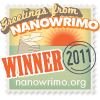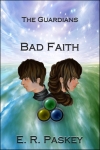 As I’ve mentioned, I am a reformed seat-of-my-pants writer. I love those sudden bursts of inspiration where I sit down and write multiple pages of something in a white-heat, but those bursts tend to work best for short stories, initial novel ideas, and scenes in an existing novel structure. I’ve learned the hard way that a lassiez-faire burst approach doesn’t work well for me when it comes to writing entire novels. The story ends up taking a meandering route that Billy from Family Circus would appreciate and it’s a nightmare to edit. Hence my increased use of outlining, plot structure, and writing consistently Monday through Friday.
As I’ve mentioned, I am a reformed seat-of-my-pants writer. I love those sudden bursts of inspiration where I sit down and write multiple pages of something in a white-heat, but those bursts tend to work best for short stories, initial novel ideas, and scenes in an existing novel structure. I’ve learned the hard way that a lassiez-faire burst approach doesn’t work well for me when it comes to writing entire novels. The story ends up taking a meandering route that Billy from Family Circus would appreciate and it’s a nightmare to edit. Hence my increased use of outlining, plot structure, and writing consistently Monday through Friday.
Plus, I’ve learned that not knowing where I’m going or having a lack of description of my environment leads to writer’s block. (Which, as Brandon Sanderson put it in his NaNo Week 4 pep talk, would be better described as “creativity block”.) This was one of those realizations that changed my writing life.
My periods of burst writing are usually stories or scenes that have been brewing inside my head long enough for me to have a good mental grasp on them. That’s why they pour out so effortlessly that sometimes that I’m always afraid I won’t be able to type or write fast enough to keep up.
I tend to run into trouble in sections where I don’t have a good grasp on things. I’m not familiar with a character or a setting, or I need to invent characters or settings. The burst of inspiration tapers off and dries up until I have those things figured out and then I’m off again.
On a side note, I also noticed that those slow days were the times I faced the most temptation for procrastination. I don’t think I’ve ever had so many urges to check my email or look up recipes, or read other writers’ blogs as I did during November. I probably would have done better on a few of those slow days if I hadn’t given in to temptation. You don’t realize how much time is slipping by until you look at the clock and realize that your writing block is up and it’s time to start dinner.
At any rate, NaNoWriMo confirmed my suspicions. As long as I have characters, setting, and a general idea of what needs to happen, writing went very well. When I didn’t have those things, I slowed down considerably.
Even then, I managed to write over 50,000 words to complete the challenge. I’ve never written that much in four weeks before. In fact, up until November, my weekly average has been in the neighborhood of 5000-6000 words.
If you’re shooting for a book or so a year, that’s still fairly respectable. But as I learned this past month, I’m capable of writing much more than that in a week. All it takes (for me—your mileage may vary), is a bit of planning and forethought.
Oh, yeah, and time. *grin* All the planning in the world doesn’t do you a bit of good if you never sit down and actually write.
This, I think, ties directly into the current hubbub about fast writing. Myths about fast writing equaling terrible writing abound. (Long-time writer Dean Wesley Smith debunks that myth here.) The goal is not to simply throw words at the wall in the hopes that some of them will stick—although some times that’s a good way for a beginner to get started, or to overcome a block—but the goal is to write well, however long or short a time it takes.
I mentioned Brandon Sanderson’s pep talk earlier. Out of all the NaNo pep talks I read, I identified with his the most. One of the things that especially resonated with me was his mention of writer’s “writing reservoirs” or “creative wells”.
He said, “One thing that non-writers don’t understand is that for most of us, we have a kind of “writing reservoir” inside of us. Consider it a creative well that can be tapped only so far in a given day. Once it runs dry, it’s often hard to create anything, even if we have the time to do so.”
He continued on to say, “One of the lessons I learned as a storyteller was how to refill the creative well while doing other activities. You can do it while driving, exercising, eating . . . anything that doesn’t take your full attention. During these times, many writers I know run through plots in their heads, feel out character personalities, think about conflicts. They make connections, overcoming blocks.”
That is so true, and not just for November. When I get stuck or need to think through a plot point, I like to take a walk up and down our driveway for a change of scenery and some fresh air. Granted, it’s a little more problematic when it’s pouring rain or there’s a lot of ice and snow outside, but it helps. 😛
I would also add that a writer needs to refuel by reading other material. We are wordsmiths, after all. 🙂 That said, music, movies, and TV can all play a role in helping to refill that creativity well again with new words, ideas, ect..
To some extent, I wish I’d tried NaNoWriMo years ago. Realizing that I can in fact accomplish 10K-12K words a week, even with unexpected curveballs in life, has been both mind-blowing and incredibly freeing. I’ve got a whole list of stories I’d love to tell—now I know it’s not going to be twenty years before I get to them. *grin*
Didn’t get to story evolution and TOSOTH’s twist today, but I’ll talk about them in the next post.
——
 Bad Faith, the first book in my sci-fi series, The Guardians, is now available. You can get a physical copy through either Amazon or Barnes & Noble. Sample chapters are available from all ebook providers, or you can read the first three chapters here.
Bad Faith, the first book in my sci-fi series, The Guardians, is now available. You can get a physical copy through either Amazon or Barnes & Noble. Sample chapters are available from all ebook providers, or you can read the first three chapters here.
For the Kindle copy, please use this link.
To purchase it through Barnes & Noble for your Nook, please use this link.
To purchase it through iTunes for your iPad/iPhone/iPod, just hit this link.
